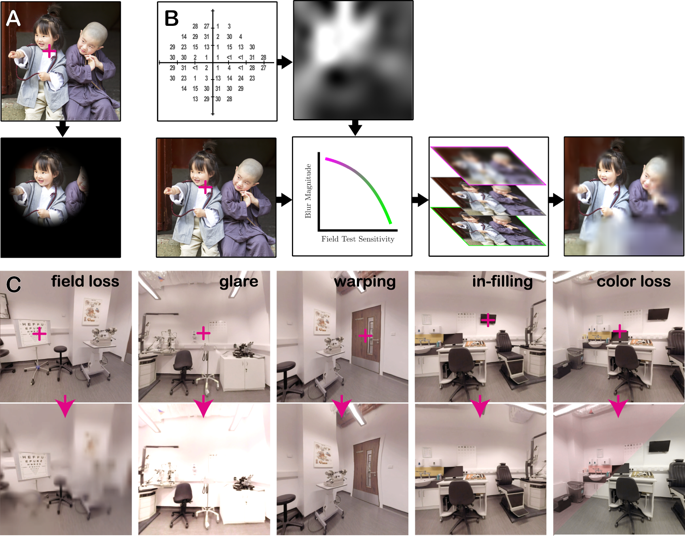npj Digital Medicine ( IF 15.2 ) Pub Date : 2020-03-10 , DOI: 10.1038/s41746-020-0242-6 Pete R Jones 1, 2, 3 , Tamás Somoskeöy 1 , Hugo Chow-Wing-Bom 2, 3 , David P Crabb 1

|
Simulations of visual impairment are used to educate and inform the public. However, evidence regarding their accuracy remains lacking. Here we evaluated the effectiveness of modern digital technologies to simulate the everyday difficulties caused by glaucoma. 23 normally sighted adults performed two everyday tasks that glaucoma patients often report difficulties with: a visual search task in which participants attempted to locate a mobile phone in virtual domestic environments (virtual reality (VR)), and a visual mobility task in which participants navigated a physical, room-scale environment, while impairments were overlaid using augmented reality (AR). On some trials, a gaze-contingent simulated scotoma—generated using perimetric data from a real patient with advanced glaucoma—was presented in either the superior or inferior hemifield. The main outcome measure was task completion time. Eye and head movements were also tracked and used to assess individual differences in looking behaviors. The results showed that the simulated impairments substantially impaired performance in both the VR (visual search) and AR (visual mobility) tasks (both P < 0.001). Furthermore, and in line with previous patient data: impairments were greatest when the simulated Visual Field Loss (VFL) was inferior versus superior (P < 0.001), participants made more eye and head movements in the inferior VFL condition (P < 0.001), and participants rated the inferior VFL condition as more difficult (P < 0.001). Notably, the difference in performance between the inferior and superior conditions was almost as great as the difference between a superior VFL and no impairment at all (VR: 71%; AR: 70%). We conclude that modern digital simulators are able to replicate and objectively quantify some of the key everyday difficulties associated with visual impairments. Advantages, limitations, and possible applications of current technologies are discussed. Instructions are also given for how to freely obtain the software described (OpenVisSim).
中文翻译:

看到其他观点:评估使用虚拟和增强现实来模拟视觉障碍(OpenVisSim)
视觉障碍的模拟用于教育和告知公众。然而,仍然缺乏关于其准确性的证据。在这里,我们评估了现代数字技术模拟青光眼引起的日常困难的有效性。23 名视力正常的成年人执行了青光眼患者经常遇到的两项日常任务:一项是视觉搜索任务,其中参与者尝试在虚拟家庭环境(虚拟现实 (VR))中定位手机;另一项是视觉移动任务,其中参与者导航物理、房间规模的环境,同时使用增强现实(AR)覆盖损伤。在一些试验中,使用来自患有晚期青光眼的真实患者的视野数据生成的注视相关模拟暗点出现在上半视野或下半视野中。主要结果指标是任务完成时间。眼睛和头部的运动也被跟踪并用于评估观看行为的个体差异。结果表明,模拟损伤严重损害了 VR(视觉搜索)和 AR(视觉移动)任务的表现(均P < 0.001)。此外,与之前的患者数据一致:当模拟视野丧失 (VFL) 较差时,损伤最大(P < 0.001),参与者在较差 VFL 条件下进行更多的眼睛和头部运动(P < 0.001),参与者认为较差的 VFL 条件更困难(P < 0.001)。值得注意的是,较差和优越条件之间的表现差异几乎与优越 VFL 和完全没有损伤之间的差异一样大(VR:71%;AR:70%)。我们的结论是,现代数字模拟器能够复制并客观量化与视觉障碍相关的一些关键日常困难。讨论了当前技术的优点、局限性和可能的应用。还给出了如何免费获取所描述的软件 (OpenVisSim) 的说明。



























 京公网安备 11010802027423号
京公网安备 11010802027423号